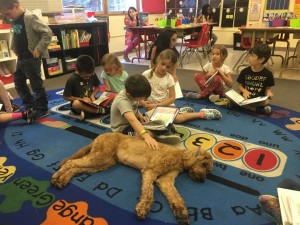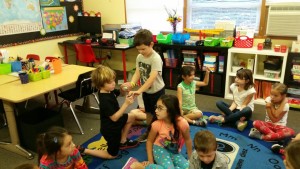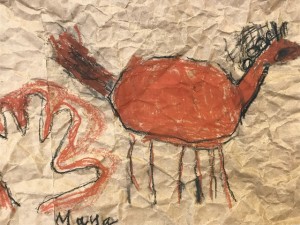Literatura
This week we read, sang, and acted out Canción del bichito de luz and Los 3 Perritos. Our learning objectives this week were to:
- read, trace, write and use our sight words in sentences: may, el, bebé, yo.
- correctly form our daily letters in upper and lower case: Ii, Jj, Kk, Ll.
- identify beginning sand endings of words and spaces between words.
- identify rhyme within a poem.
- create rhymes with their own names.
- segment syllables, identify the initial and final sound in given words.
- use capital letters for names of people, states, and cities.
First graders are meeting with me multiple times a week in reading groups. They should practice reading their books on a daily basis. They each have an incentive chart and can mark their chart for each book they read. They will go to the treasure box each time they fill their incentive chart.
Kindergarteners will be receiving their readers in a few weeks and will have the opportunity to fill out their own incentive charts for trips to the treasure box.
Matemáticas
Our math objectives for this week were to:
- create number bonds
- identify missing numbers from number bonds
- use a number balance to check our number bonds
- add within 0-10
- write our numbers correctly
History & Geography
This week we wrapped up our landform unit by playing a landform riddle game and acting out different landforms. On Tuesday we begin a new unit on Early World Civilizations. We’ve started off with Mesopotamia as our first civilization to study.
Our objectives this week were to
• Identify and locate the Middle East on a map of Asia.
• find the area known as Mesopotamia on the map and understand that this was part of Asia
• explain the importance of the Tigris and Euphrates rivers, and the use of canals, to support farming
• describe the city of Babylon
• identify cuneiform as a way of writing in Mesopotamia
• explain why writing is important to a civilization
Science 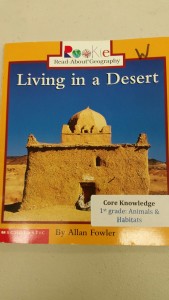
This week we took a pause and reviewed what we’ve learned so far about the three habitats that we had studied. At the end of the week we began our next unit on the East African Savanna. We watched a short video on animals from this region.
Our objectives this week were to:
• describe the three things that a habitat must have
• review what we have learned about the Arctic Ocean, Arctic Tundra, and the Sonoran Desert
• review what it means to classify animals as herbivore, carnivore, omnivore
• identify the characteristics of the grassland habitat, specifically the East African Savanna
• identify four geographical regions of Africa on a map
English Word Work 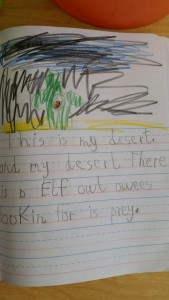
This week in spelling the blue group worked on d and f sounds, the blue group had the ap and ad family words, and the green group worked on ad, ab, ed, ob words. In our journals we wrote and drew things about our desert . Our word wall words this week were: what, this, here, there, where, why, who, how
Our vocabulary words this week were: desert, canals, trade, Savanna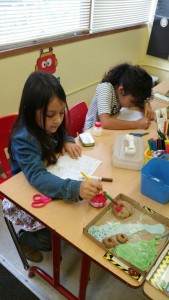
Specialists
Character Education: I so enjoyed having the students bring in one of their “favorite things” over the past few weeks! It’s such a fun “get to know you” activity. This took a bit more time than anticipated, so we are finishing up our theme on Manners next week and then will move on to our next theme: Friendship, Cooperation, and Teamwork. In K-3rd grades, we will be reading some great books including The Name Jar by Yangsook Choi, and Amos and Boris by William Steig. Our poem will be a seasonal one, called Something Called the Wild Geese by Rachel Lyman Field. Be sure to check the bulletin board to see more books, as well as the poem, song, and quote we’ll focus on for the next several weeks.
We jumped right in with art history this month, and the students learned about ancient Cave Paintings and also ancient Egyptian art.
We made our own textured “rock” surfaces by crumpling paper grocery bags, and the students learned how to use basic shapes to draw either a deer or a horse. The students used oil pastels similar in color to the red ochre rocks that prehistoric people used to make crayons and paint. The students “signed” their paintings with hand prints like the ones found in several cave paintings.
We looked at some famous Egyptian art and jewelry, and learned that the Egyptians used carvings of Dung Beetles in much of their art work. Egyptians revered the dung beetle (a type of Scarab Beetle) which makes balls of dung as a nest and food source for their eggs!
The students learned how to use basic shapes to draw a beetle, and then they used watercolors to mix yellow and blue to paint their beetle green.
All the kiddos did a great job this month, and we will start some Fall Leaf projects in October.
October Music with Ms. Erin

